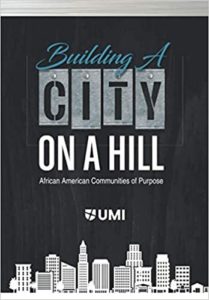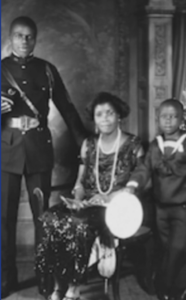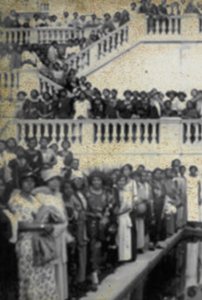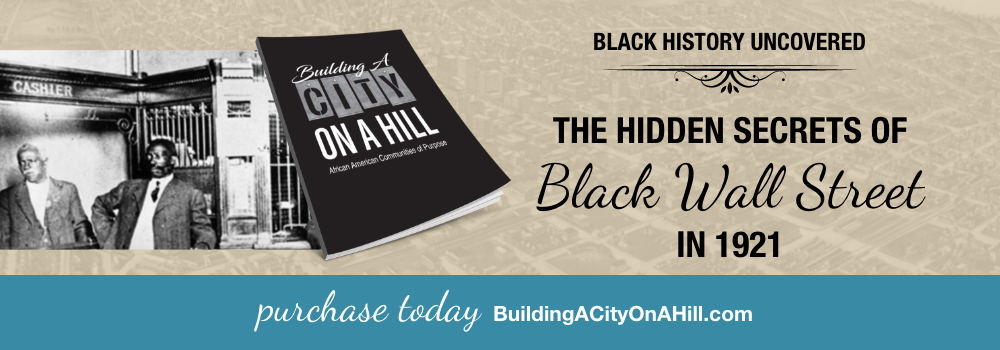
Our rural and urban Black communities deserve better. Take the stories and biblical connections in
Building a City on a Hill and use them to make a difference.
On May 30th, 1921, in Greenwood, Oklahoma, a blood-thirsty mob burned down a wealthy and prosperous Black community because of a false accusation.
Tulsa’s north side was a prosperous community, exclusively Black because Jim Crow law had prohibited Negroes from living in white neighborhoods, where it was said more than 3,000 Klu Klux Klan members resided in the area. At that time, there were countless all-Black communities like Greenwood scattered throughout the US. 60 in Oklahoma territory alone. Greenwood, however, was the jewel of Negro America. Though white Tulsan’s called it Little Africa, Booker T. Washington gave it the name we know today, Black Wall Street. And it was the wealthiest Black community in America where Black men and women came to pursue the American dream. It boasted Black-owned banks, pharmacies, grocery stores, movie theaters, restaurants, churches, newspaper publishing, law offices, a bus company, its own school district where the average student wore a uniform with a suit and tie, a business college, a hospital with an entire Black staff and an internationally acclaimed surgeon, Black millionaires, which Greenwood was known to have had more millionaires residing there than the entire United States combined.
One of the only two airports in the state of Oklahoma was for the half dozen private airplanes owned by its Black oil tycoons. To top it off, the minimum wage and living standard of a resident of Black Wall Street far exceeded Tulsa’s average white citizen, but on May 30th, 1921, all that changed. Dick Rowland, a shoeshine boy, entered the Drexel building elevator to use only a few colored bathrooms in downtown Tulsa. On the top floor, Sarah Page, a 17-year-old white elevator operator, began operating the elevator when it lurched, causing Rowland to stumble. He bumped into Sarah, and she screamed. Rowland knew what Frederick Douglass had penned as the truth regarding the treatment of Black men in America. To be accused was to be convicted, and to be convicted was to be punished.
 In this case, when it came to a white woman’s accusations, punishment meant death, and knowing her scream was a likely death sentence, young Rowland ran away. He was later seized and apprehended with the intent of being lynched. Word of a Black man raping a defenseless white girl spread throughout the Tulsa area. Dozens and then hundreds of white men grew to a mob of over 2000 white men gathered at the County courthouse demanding justice. But justice for what? Sarah Page wasn’t assaulted, her clothes weren’t ruffled, and though her story wavered during questioning, she ultimately affirmed she was not harmed.
In this case, when it came to a white woman’s accusations, punishment meant death, and knowing her scream was a likely death sentence, young Rowland ran away. He was later seized and apprehended with the intent of being lynched. Word of a Black man raping a defenseless white girl spread throughout the Tulsa area. Dozens and then hundreds of white men grew to a mob of over 2000 white men gathered at the County courthouse demanding justice. But justice for what? Sarah Page wasn’t assaulted, her clothes weren’t ruffled, and though her story wavered during questioning, she ultimately affirmed she was not harmed.
Moreover, she refused to sign a statement saying that she had been raped. But don’t let the facts get in the way of a false accusation of a Black man who needed to be put in his place — at the end of a rope. The Tulsa Tribune headlines screamed, “A Negro Assaults a White Girl.”
And later, “To Lynch Negro Tonight.”
With no basis and fact for the allegations of rape, the mob persisted in their demand for justice of a white girl who emphatically stated that no injustice had been done. Walter White of the New York Evening Post wrote, “Chief of police, John A Gustafsson, sheriff McCullough, mayor T.D. Evans and many reputable citizens, among them a prominent oil operator, all declared the girl had not been molested, that no attempt at criminal assault had been made. Victor F. Barnett, the managing editor of The Tribune, stated that his paper had since learned that the original story that the girl’s face was scratched, and her clothes torn was untrue.”
 And there you have it, fake news. But the damage had already been done, and the wheels were set in motion. Armed Black World War 1 veterans were among the less than 100 members of the Greenwood community who came to prevent another lynching of a Black man, as thousands had been lynched since the generation of reconstruction. A verbal confrontation led to a shot being fired, triggering what would soon become the bloodiest racial conflict in American history. Some 500 members of the white mob were armed and deputized by city officials, and those who didn’t own weapons looted stores to obtain guns and ammunition along the way. Thousands of angry white men descended upon “Little Africa” as a few white families provided sanctuary to those fleeing from violence.
And there you have it, fake news. But the damage had already been done, and the wheels were set in motion. Armed Black World War 1 veterans were among the less than 100 members of the Greenwood community who came to prevent another lynching of a Black man, as thousands had been lynched since the generation of reconstruction. A verbal confrontation led to a shot being fired, triggering what would soon become the bloodiest racial conflict in American history. Some 500 members of the white mob were armed and deputized by city officials, and those who didn’t own weapons looted stores to obtain guns and ammunition along the way. Thousands of angry white men descended upon “Little Africa” as a few white families provided sanctuary to those fleeing from violence.
For 24 hours, the mob looted, murdered, and raised the wealthiest Black city in America to the ground. Eyewitness testimony stated a dozen or more planes circled the Black area, dropping burning turpentine balls over Greenwood’s city and firing bullets at Black residents, young and old, gunning them down in the streets. It was the first and only time Americans used planes to attack and kill their own citizens, as it destroyed an entire city. Authorities engaged in a concerted effort to prevent help from arriving until considerable damage was done by cutting off communication, requesting help, blocking transportation ways of firefighters and ambulances, and even preventing the Red Cross from coming in earlier to help the injured and terrorized community.
“As they passed the city’s most traveled street, they held both hands high above their heads, their hats in one hand, as a token of their submission to the white man’s authority. They will not return to the homes they had on Tuesday afternoon, only the heaps of ashes, the angry white man’s reprisal for the wrong inflicted on them by the inferior race,” reported the Tulsa Tribune.
Following the massacre, insurance companies refused to compensate the residents though the city and its officials were found negligent in preventing it. Decades of silence about the terror, violence, and theft passed. There were no convictions for any of the charges related to the murders or violence. Not one white person was ever held responsible for these crimes, though dozens of Black men were indicted for inciting a riot. Government and city officials not only failed to invest and rebuild the once thriving Greenwood community but blocked efforts to do so and even actively sought to appropriate their land. The crime wasn’t acknowledged by the city or the state of Oklahoma for over 70 years, rarely mentioning it in the history books, classrooms, or even in private. Most residents grew into middle age, completely unaware of what had taken place. Even a report detailing Tulsa’s fire department’s history from 1897 to 2017 made no mention of the massacre.
And on that Memorial Day weekend, June 1st, 1921, Greenwood, Oklahoma, was brought to an abrupt end. Black wall street was wiped off the map. 300 African Americans murdered, possibly more. Thousands injured. More than 10,000 left homeless. Forty city blocks burned to the ground. And the few homes left were completely looted. The Tulsa Real Estate Exchange estimated property losses amounting to the equivalent of more than $32 million in today’s money. Unbeknownst to most, Tulsa’s Black Wall Street wasn’t the only Black town to be ethnically cleansed in America. It wasn’t the only city forgotten, nor was it the only Black town no one was ever arrested, prosecuted, or where victims were never compensated. Time has passed, memories have faded, and survivors have died, taking the knowledge of not only how the cities were destroyed but arguably even more tragic, the knowledge of how these countless all-Black towns were built. Can a biblical blueprint be extrapolated from what we found? That is indeed our challenge, to cooperate, coordinate, and collaborate to turn our desolate neighborhoods into thriving communities and build them up by utilizing the keys to economic and societal development. Let us rediscover, let us reunite, and let us rebuild a new Black Wall Street.

